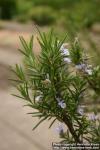
 Preparations: Spirit of Rosemary
Preparations: Spirit of Rosemary
Related entries: Oleum Rosmarini (U. S. P.)—Oil of Rosemary
The tops and leaves of Rosmarinus officinalis, Linné.
Nat. Ord.—Labiatae.
COMMON NAME AND SYNONYMS: Rosemary; Folia rosmarini, Folia roris marini, Folia anthos.
ILLUSTRATION: Bentley and Trimen, Med. Plants, 207.
Botanical Source.—Rosemary is an erect, perennial, evergreen shrub, 2 to 4 feet high, with numerous branches of an ash color, and densely leafy. The leaves are sessile, opposite, linear, over an inch in length, and about 2 lines broad, entire, obtuse at the summit, revolute at the margins, of a firm consistence, dark-green and shining above, and downy and sometimes whitish beneath. The flowers are few, bright-blue or white, subsessile, and borne in short, opposite, axillary, and terminal racemes; the bracts are shorter than the calyx; the calyx purplish, campanulate, and villose; the corolla not ringed in the inside, somewhat inflated in the throat, with 2 equal lips, the upper of which is erect and emarginate, the lower trifid, with the middle lobe very large, concave, and hanging down. Stamens 2; filaments minutely toothed near the base; anthers linear, with 2 divaricating, confluent cells. Upper lobe of style very short. Seeds 4, oblong, naked at the base of the calyx (L.—W.).
History.—Rosemary is a native of the countries surrounding the Mediterranean, and is cultivated in nearly every garden for its beauty and fragrance, flowering in April and May. The parts used in medicine are the flowering tops, which have a powerful, diffusive, camphoraceous odor, and an aromatic, bitter taste; they yield their properties to water or spirits, but more effectually to alcohol. The leaves are likewise used. Age and drying impair their odor and virtues, which are due to a volatile oil (Oleum Rosmarini), and which may be procured by distillation. On standing for some time, the oil deposits crystals of stearopten (rosemary camphor). Tannin, a bitter body, and resin are also constituents.
Action, Medical Uses, and Dosage.—Rosemary is stimulant, antispasmodic, and emmenagogue; seldom used in this country, except as a perfume for ointments, liniments, embrocations, etc. The oil is principally employed. Dose, internally, from 3 to 6 drops.

